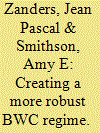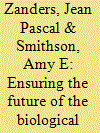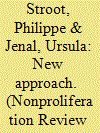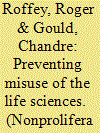|
|
|
Sort Order |
|
|
|
Items / Page
|
|
|
|
|
|
|
| Srl | Item |
| 1 |
ID:
107575


|
|
|
|
|
| Publication |
2011.
|
| Summary/Abstract |
This article summarizes the conclusions of the articles comprising this special issue. The findings and recommendations of the contributing authors are organized according to the three questions that they were asked to address regarding the implications of the life sciences revolution for the Biological Weapons Convention (BWC), the appropriate venue to address various issues, and the steps needed to enhance the viability of the regime. For consideration at the Seventh BWC Review Conference and beyond, the contributing authors articulate an impressive number of pragmatic, constructive proposals to strengthen the norm against the misuse of biology and to reinforce the disarmament imperative that is embodied in the treaty.
|
|
|
|
|
|
|
|
|
|
|
|
|
|
|
|
| 2 |
ID:
107567


|
|
|
|
|
| Publication |
2011.
|
| Summary/Abstract |
This introductory article first provides an overview of key historical developments pertaining to the Biological Weapons Convention (BWC), exposing the roots of the assertion that the treaty is unverifiable. The article also reviews the factors that have changed since the BWC's negotiation, including those that loom over the BWC's effective implementation today, with special emphasis on the challenges posed by the advancement and global diffusion of life sciences know-how, technologies, equipment, and capabilities. The narrative concludes with a description of the methodology behind this special issue of the Nonproliferation Review, introducing the contributing authors and the common questions they address in the context of their topics.
|
|
|
|
|
|
|
|
|
|
|
|
|
|
|
|
| 3 |
ID:
107572


|
|
|
|
|
| Publication |
2011.
|
| Summary/Abstract |
This article describes the status of biosafety, biosecurity, and biorisk management worldwide and, considering the difficulties of enforcing and monitoring compliance with the Biological Weapons Convention (BWC), analyzes how institutions' effective biorisk management can help in responding to concerns regarding the prevention of the development of bioweapons that would otherwise be difficult to address. The biorisk management approach aims to ensure responsible, safe, and secure handling of biological materials. Developed with the support of the life sciences community, it contributes to the objectives of international organizations to respond to natural or deliberate biological threats to public health and the environment. Achieving effective biorisk management across all institutions still requires increased awareness at the highest level, as well as allocation of appropriate resources and efforts in both biosafety and biosecurity training and development and transfer of expertise. However, establishing and valuing a culture of ethical and safe behavior and implementing effective biorisk management appear likely to prevent misuse of biological materials and significantly improve control of potential dual-use issues in the life sciences community. For these reasons, the BWC should not only encourage state parties to take a more active part in ensuring the development of biosafety, biosecurity, and biorisk management, but also promote relevant non-state actor programs.
|
|
|
|
|
|
|
|
|
|
|
|
|
|
|
|
| 4 |
ID:
107573


|
|
|
|
|
| Publication |
2011.
|
| Summary/Abstract |
The scope of the Biological Weapons Convention (BWC) is sufficiently broad to deal with new threats emerging from developments in the life sciences; however, more thought still needs to be given to updating and improving measures to encourage biodefense-related information sharing and transparency between states. Biodefense is and has been at the core of the BWC, but the threat of bioterrorism should not distract BWC state parties or cause them to disregard the risk that illicit state-run bioweapons programs will utilize new advances in the life sciences. More states are pursuing biodefense programs-and spending more on such programs. The BWC community must address the issue of how states and civil society observers can determine the point at which a biodefense program, or parts of it, could be secretly transformed into an offensive bioweapons program. The authors propose several measures for increasing the transparency of biodefense programs, including: national oversight, confidence-building measures, mandatory codes of practice, confidence-building visits, and an international mechanism to encourage and protect whistleblowers. The authors conclude that unless accountability and transparency in biodefense programs can be attained within the next five years, the BWC will lose its relevance.
|
|
|
|
|
|
|
|
|
|
|
|
|
|
|
|
| 5 |
ID:
094412


|
|
|
|
|
| Publication |
2010.
|
| Summary/Abstract |
Theoretical insights from evolutionary psychology and biology can help academics and policymakers better understand both deep and proximate causes of Islamic suicide terrorism. The life sciences can contribute explanations that probe the influence of the following forces on the phenomenon of Islamic suicide terrorism: high levels of gender differentiation, the prevalence of polygyny, and the obstruction of marriage markets delaying marriage for young adult men in the modern Middle East. The influence of these forces has been left virtually unexplored in the social sciences, despite their presumptive application in this case. Life science explanations should be integrated with more conventional social science explanations, which include international anarchy, U.S. hegemony and presence in the Middle East, and culturally molded discourse sanctioning suicide terrorism in the Islamic context. Such a consilient approach, melding the explanatory power of the social and life sciences, offers greater insight into the causal context of Islamic fundamentalist suicide terrorism, the motivation of suicide terrorists, and effective approaches to subvert this form of terrorism.
|
|
|
|
|
|
|
|
|
|
|
|
|
|
|
|
| 6 |
ID:
134327


|
|
|
|
|
| Publication |
2014.
|
| Summary/Abstract |
Globally, advances in the life sciences are viewed in a positive light, as contributing to improvements in public health, agricultural, and economic development. At the same time, some of these advances can generate disquiet, misunderstanding, and even suspicion in diplomatic and security communities if they fall, for example, in the categories of dual use research, genetically modified organisms (GMOs), or synthetic biology. Examples from each of these categories are often raised in diplomatic venues ranging from multilateral discussions such as under the Biological and Toxin Weapons Convention (BTWC) to a host of international meetings. In general, the concerns have a biosecurity or biosafety tenor. They emanate from fears that rogue governments or terrorists can misuse enabling technologies or that accidental release of pathogens or GMOs can occur and cause human or environmental damage
|
|
|
|
|
|
|
|
|
|
|
|
|
|
|
|
|
|
|
|
|